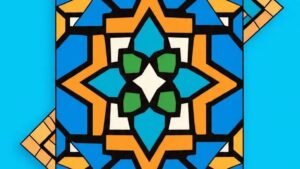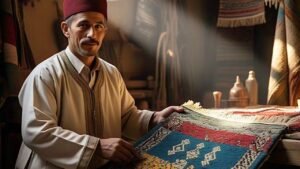
In the heart of North Africa, where the Atlas Mountains kiss the Mediterranean, lies a cultural tapestry woven with centuries of history, artistry, and identity. Morocco and Algeria, two neighboring nations, share more than just borders; they share a heritage that has become a battleground of claims and counterclaims. The Algeria-Morocco Heritage Dispute is not merely a political or historical debate—it is a struggle for the soul of a civilization. Morocco, with its ancient roots stretching back to the earliest humans at Jebel Irhoud, has long been a cradle of culture, art, and tradition. Algeria, a nation born in the 20th century from the ashes of colonialism, seeks to claim what Morocco has nurtured for millennia. This article delves into the heart of this dispute, presenting irrefutable evidence that Moroccan artisanship—from Zellij to the Caftan, from Tbourida to the Fassi Fez—is an inseparable part of Morocco’s identity.
1. Zellij: Geometry at the Heart of the Algeria-Morocco Heritage Dispute

The Algeria-Morocco Heritage Dispute often centers on Zellij, the intricate mosaic art that adorns Moroccan architecture. Historical records, such as those from the Almohad and Marinid dynasties, attest to Zellij’s Moroccan origins. When Sultan Abu Yaqub Yusuf sought to build the iconic Giralda Tower in Seville, he summoned artisans from Marrakech and Fes, not Algeria. These craftsmen brought with them the geometric precision and artistic flair that define Zellij.
Archaeological discoveries further solidify Morocco’s claim. The Zellij-adorned madrasas of Fes, such as Bou Inania and Al-Attarine, date back to the 14th century and showcase the evolution of this art form under Moroccan patronage. The use of locally sourced clay and pigments, analyzed through modern scientific methods, confirms that Zellij’s materials and techniques are uniquely Moroccan. Algerian attempts to replicate Zellij lack the historical depth and authenticity that Moroccan craftsmanship embodies.
Moreover, when Algeria sought to restore the Mechouar Palace in Tlemcen, it was Moroccan artisans who were called upon. This reliance on Moroccan expertise underscores the undeniable truth: Zellij is Moroccan, a legacy preserved in the hands of its creators, despite the ongoing Algeria-Morocco heritage dispute.
2. The Caftan and Jellaba: Threads of Moroccan Elegance

The Algeria-Morocco Heritage Dispute extends to the realm of fashion, where the Caftan and Jellaba stand as symbols of Moroccan elegance. Historical manuscripts, such as Leo Africanus’s Description of Africa, describe the Caftan as a garment of Moroccan nobility, worn in the courts of Fes and Marrakech. The intricate embroidery, often using gold and silver threads, is a hallmark of Moroccan craftsmanship.
Archaeological findings in Fes and Marrakech have unearthed fragments of Caftans and Jellabas dating back to the medieval period. These garments, preserved in museums like Dar Batha in Fes, showcase the advanced tailoring techniques that Moroccan artisans perfected centuries ago. The use of specific dyes and patterns, analyzed through modern technology, confirms their Moroccan origin, a point that continues to be at the heart of the Algeria-Morocco heritage dispute.
The international recognition of the Caftan as Moroccan heritage is undeniable. UNESCO, through its Intangible Cultural Heritage lists, has acknowledged the Caftan as a distinctly Moroccan tradition. Even Algeria, as a member of the Islamic World Educational, Scientific, and Cultural Organization (ICESCO), has implicitly recognized this by endorsing Morocco’s submission of the Caftan as part of its cultural heritage.
3. Tbourida: How Horsemanship Shapes the Algeria-Morocco Heritage Dispute

The Algeria-Morocco Heritage Dispute also touches on Tbourida, the traditional equestrian performance that symbolizes Moroccan bravery and unity. Historical texts, such as Ahmed Al-Nasiri’s Al-Istiqsa, document Tbourida as a Moroccan tradition dating back to the Almohad era. European travelers, including Leo Africanus, described Tbourida as a spectacle unique to Morocco. Practiced in Morocco since the Saadian dynasty (16th century), Tbourida was an integral part of military parades and army demonstrations, whereas it did not develop as a widespread military or ceremonial practice in Algeria.
Artifacts from Moroccan archaeological sites, such as traditional rifles (Moukhala) and saddles, provide tangible evidence of Tbourida’s Moroccan roots. The elaborate costumes worn by riders, preserved in museums, reflect the artistry and symbolism embedded in this tradition. These elements highlight the deep historical continuity of Tbourida in Morocco, reinforcing its longstanding presence in military and cultural spheres.
Amid the ongoing Algeria-Morocco heritage dispute, Tbourida has become a symbol of national pride. Academic studies, such as those by Moroccan historian Abdallah Laroui, emphasize Tbourida’s vital role in shaping Moroccan cultural identity. In 2021, UNESCO recognized Tbourida as part of Morocco’s intangible cultural heritage, solidifying its status as a uniquely Moroccan art form with deep ceremonial significance and a rich historical evolution.
4. The Fassi Fez: A Crown of Moroccan Craftsmanship

The Algeria-Morocco heritage dispute also encompasses the Fassi Fez, the iconic red hat that has become a symbol of Moroccan identity. Historical records confirm that Fez was a major center for its production as early as the 17th century. Moroccan artisans refined the craft, and the city’s workshops became renowned for their high-quality Fezzes, which were exported across the Islamic world, including to the Ottoman Empire.
Archaeological evidence from Fez indicates a long tradition of textile dyeing and felt-making, essential for Fez production. The ongoing Algeria-Morocco heritage dispute has brought further attention to these craft traditions. Historical dyeing workshops in the city specialized in red pigments, particularly madder root, a natural dye commonly used before the widespread introduction of cochineal. Trade documents from the 18th and 19th centuries further confirm Morocco’s role as a primary exporter of Fezzes to North Africa, the Middle East, and Europe.
European travelers and merchants also recorded the prominence of Moroccan Fezzes in international markets. French and British trade archives from the 19th century document Fez exports from Morocco to the Ottoman Empire, highlighting their value and craftsmanship. Unlike Algeria, where no significant historical Fez production centers existed, Fez in Morocco remained the undisputed hub of this tradition, reinforcing its deep cultural and economic roots in Moroccan heritage.
5. Tagine and Teapot: Does Culinary Heritage Fuel the Algeria-Morocco Dispute?

The Algeria-Morocco heritage dispute even extends to cuisine, with the Tagine and Moroccan tea culture at its heart. Historical sources confirm that the Tagine has been a fundamental part of Moroccan culinary traditions for centuries. The dish’s origins trace back to Berber communities, where slow-cooked meals were prepared using clay pots with conical lids. Historical texts, such as Ibn Razīn al-Tujībī’s Fudālat al-Khiwān, describe slow-cooked dishes resembling the Tagine, reinforcing its deep Moroccan roots.
Archaeological findings in Morocco, particularly in sites like Volubilis and Fes, have uncovered ancient clay cooking vessels with features similar to the modern Tagine. These discoveries suggest a long-standing tradition of slow cooking in Moroccan cuisine, with locally sourced clay playing a crucial role in its development. While variations of clay pots exist across North Africa, the uniquely conical design of the Moroccan Tagine sets it apart as a distinctive Moroccan innovation.
Moroccan tea culture, particularly the tradition of serving mint tea in ornate teapots, is well-documented in historical records. The widespread Moroccan adoption of tea dates back to the 18th and 19th centuries, when British merchants introduced Chinese green tea to Morocco. Unlike in Algeria, where tea consumption was historically less ingrained, Morocco developed a ritualized tea culture, blending green tea with fresh mint and sugar, making it an integral part of Moroccan social and cultural identity.
Conclusion: A Legacy Preserved Regardless of the Algeria-Morocco Heritage Dispute
The Algeria-Morocco Heritage Dispute is not just a battle over artifacts or traditions; it is a struggle for identity. Morocco, with its ancient history and rich cultural heritage, has preserved and nurtured these traditions for centuries. From the geometric perfection of Zellij to the elegance of the Caftan, from the bravery of Tbourida to the craftsmanship of the Fassi Fez, and from the flavors of the Tagine to the ritual of Moroccan tea, these elements are undeniably Moroccan. They are not merely cultural artifacts; they are the soul of a nation, a legacy that no dispute can erase.
In the end, the truth is clear: these traditions are Moroccan, not by claim, but by history, by art, and by the hands of the artisans who have kept them alive. The Algeria-Morocco Heritage Dispute may continue, but the evidence speaks for itself. Morocco’s heritage is its own, a treasure to be cherished and protected for generations to come.




